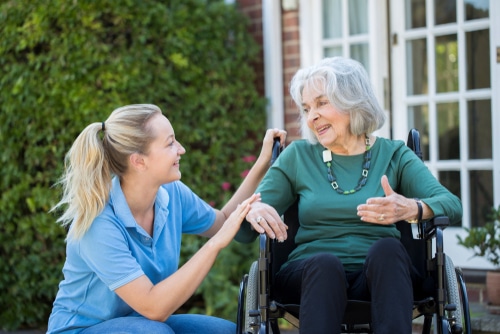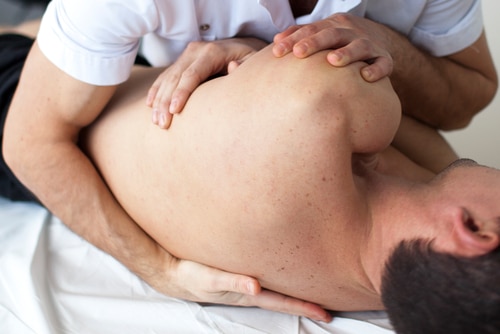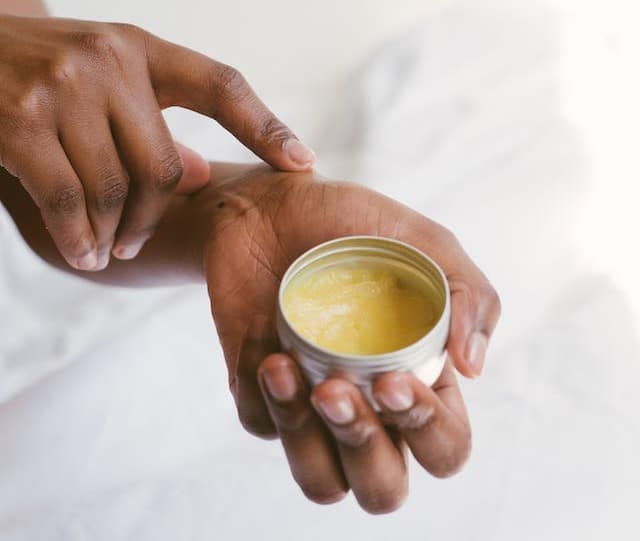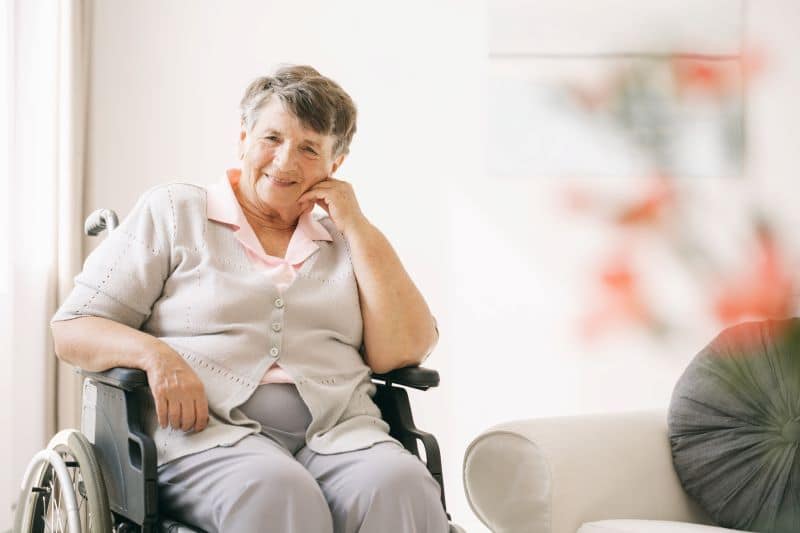Pressure sores come by many names. They’re known as bedsores, pressure injuries, pressure ulcers or decubitus ulcers. Regardless of what you call them, they’re painful and slow healing so prevention is important.
Being in a seated position for a lengthy amount of time can increase the pressure on the skin and deeper tissues. That’s why preventing or treating pressure sores is important for anyone using a wheelchair.
In this article Blue Badge Insurance looks at how to prevent pressure sores for wheelchair users. We cover causes, symptoms, complications and treatment. Take a look:
In this article

What is a pressure sore?
Very much like the name suggests, a pressure sore is a wound that develops from continuous pressure on the affected area. This could, for instance, be from sitting in the same position for too long in a wheelchair or being bedridden (hence the name ‘bedsores’).
Click here to see what they look like.
Who is at risk?
People with limited mobility, whether from a physical disability or perhaps from ageing, can be at high risk of getting pressure sores. Those of us who are active and mobile may take for granted that even a walk between different rooms in the house or stepping outside for a moment help keep our circulation moving.
Anyone with limited mobility and a health condition such as diabetes that affects circulation are often at most risk because of the compounded health issues.
What happens?
Staying in the same position for extended periods at a time means that the blood flow slackens. In areas of the body that press against hard surfaces, the blood flow can be so restricted that the tissues don’t get enough to stay healthy.
Areas that have bones just beneath the skin’s surface and are in constant contact with surfaces can be high risk parts of the body. These include sticky-outy bits like our elbows, heels, toes, the back of the head, behind the knees, hips, tailbone and shoulder blades.
And if you don’t treat it?
The skin and underlying tissues that are affected need to be treated or they can begin to die, leading to serious health and often irreversible health complications. The infection can penetrate from the soft tissues into the bone.
The danger of pressures sores is that they can cause secondary health conditions. These include abscesses, cancer, infections in the bone tissue, inflammation and sepsis.

Pressure sore stages
There are four main stages or grades of pressure sores. If left untreated a first stage pressure sore can develop to a second then third then fourth stage wound, making it more serious as a health risk and more complex to treat.
The four stages of these pressure sores or bedsores can be outlined as follows:
| Stage 1 | Skin discolouration (red/purple/blue depending on your skin tone, with deeper skin tone having purple or blue), heat at the pressure point and possible itching, burning or pain |
| Stage 2 | Further damage and loss to top layers of skin, resulting in a wound (such as a blister or opening) and leading to more serious pain and continued skin discolouration |
|---|---|
| Stage 3 | Layers of skin begin to die at the site of the pressure sore, causing a crater like appearance |
| Stage 4 | Tissues beyond the skin, such as muscles, tendons, joints and bones, begin to die, resulting in a larger would and serious health risks |

Preventing pressure sores
Prevention is always the best path to take. Not only can treatment options be costly but pressure sores can take up to years to heal depending on the severity.
Preventing them from forming can be simple and involves basic tasks such as changing one’s position. Usually a person who is at risk of developing pressures will need the support of another person like a family member or carer to assist them.
Preventing bedsores or pressure sores can include the following lifestyle factors:
🟢 Movement
Changing position is key because this reduces the pressure on the prone areas. If you’re seated in a wheelchair because of a stroke or spinal cord injury this may be difficult to do yourself. Additionally, areas of the body that are immobile can be desensitised.
The nerves may not send the signals to indicate a change in position is needed. Normally if someone sits or lies down for too long in the same position they’ll notice discomfort. As a result, they’re likely to shift to a new position. Without either the option to change your own position or the body sending signals to tell you to change positions, having someone assist is important.
If you’re in a wheelchair, your position should be adjusted every 15 minutes or so. For people who are in bed, repositioning during the day and night should be done every two hours at the minimum to avoid bedsores developing.

🟢 Diet
Eating well is often overlooked but we really can’t be healthy unless we eat a balanced diet. Importantly, everyone’s body is different and requires a suitable balance of protein, liquids, vitamins and minerals and the right number of calories.
Ideally ask your medical professional to recommend a nutritionist who can help with your needs or the needs of the person you’re taking care of. It’s important to keep in mind that treatment of bedsores won’t be successful unless it’s also accompanied by a healthy, balanced diet.
Weight management is key – something that’s directly linked to eating the right food in the right quantities. Learn about ordering in healthy and nutritious ready-made meals in our article on home delivery meals.
🟢 Technology and accessories
There are plenty of pressure dispersing accessories such as wheelchair cushions or sheepskin throws. These can add a soft layer that helps distribute pressure a little more evenly.
Read our tips on making your wheelchair more comfortable. Also check out the lambswool cushion in our guide to Christmas gifts for people in wheelchairs.
Technology like pressure-sensing mats can be used in bed or with a wheelchair. These help monitor the pressure on your body. Technology like this helps evaluate the moisture content of the skin as well as movement or lack of.
🟢 Skin care
Like diet, skin care may seem simple but that simplicity could mean it’s overlooked. Pressure sores begin in the surface layers of the skin and progress to the underlying tissues. Keeping the skin clean and healthy and doing daily checks is important.
Use a good moisturiser to stop skin from becoming too dry and ensure it doesn’t become too moist either. While massage can promote healthy circulation, keep in mind that skin around areas prone to bedsores is more delicate. This means the skin around bones and joints shouldn’t be massaged, to avoid it becoming injured.
Some inclusive fashion brands like Christina Stephens have included fabrics and designs that are good for the skin. They even design clothing that specifically focuses on reducing the risk of pressure sores for people in wheelchairs.

Pressure sore treatment
Each of the factors mentioned to prevent pressure sores is also needed during treatment. On the advice of your medical professional, various levels of treatment will be used. The selection depends on the grade of pressure sore.
These can include taking medication, using topical treatments, surgery and negative pressure wound therapy. Surgery can include removing affected areas and replacing them with skin and bone grafts.
Protecting your freedom of movement
For anyone who relies on mobility equipment like a wheelchair or mobility scooter, preserving your health is important. Keeping your equipment safe is too because it’s integral to your freedom of movement.
Blue Badge Insurance can give you the safety net of insurance for your wheelchair, scooter or car. We also offer pet insurance for pets and Assistance Dogs. Each of these types of insurance helps to pay for the cost of your equipment or car getting accidentally damaged or being written off or stolen. For pets, having insurance helps pay for unexpected vet costs.
Find out more about our wheelchair insurance and mobility scooter insurance. Your disability parking permit also gets you some insurance discounts with Blue Badge. Like up to 25% off disability car insurance or car insurance for wheelchair accessible vehicles and disability converted cars. It also gets you up to 15% off pet insurance and 25% off Assistance Dog Insurance.
Find out more by getting a quote by simply clicking below.








